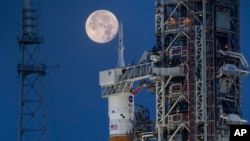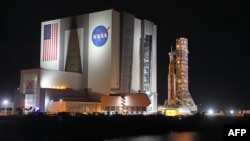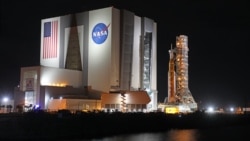The American space agency NASA has postponed two moon missions that are facing development and safety issues.
NASA’s program to return astronauts to the moon for the first time since NASA’s Apollo 17 mission in 1972 is called Artemis. The agency split the program into three parts.
In 2022, Artemis I sent NASA’s Orion spacecraft on a trip around the moon without a crew. The agency’s huge Space Launch System (SLS) rocket carried Orion into space. The spacecraft traveled more than 400,000 kilometers from Earth and completed a close fly-by of the moon. NASA officials declared Artemis I a big success.
The second planned trip, Artemis II, was set for late 2024. The goal was to send Orion on the same path Artemis I took, but with four astronauts. NASA announced last week it had set a new September 2025 target for the launch of Artemis II.
The third mission, Artemis III, will attempt to land astronauts on the surface of the moon. NASA says the crew is expected to include “the first woman and the first person of color.” Artemis III was planned for 2025 but has now been pushed back to September 2026.
NASA Administrator Bill Nelson said the postponements were necessary in order to give the agency time to deal with several ongoing problems affecting the Artemis program. “Safety is our top priority," Nelson said. He added that the delays will “give Artemis teams more time to work through the challenges.”
NASA’s announcement about the delays came shortly after the successful launch of a private American company’s spacecraft that aimed to land on the lunar surface.
That spacecraft, called Peregrine, is a moon lander built by Pennsylvania-based Astrobotic Technology. It launched January 8 aboard a Vulcan Centaur rocket built by America’s United Launch Alliance (ULA).
Immediately after Peregrine’s launch, Astrobotic officials praised the mission as the first step to becoming the first private space vehicle to land on the moon. But shortly after the launch, a fuel leak was discovered.
Astrobotic has said the spacecraft would continue on its mission while leaking fuel but faces ongoing power and propulsion problems. The company aims to keep the lander going as long as possible and to collect data from its instruments. But officials from Astrobotic have said Peregrine is no longer expected to land on the moon.
Peregrine is part of NASA's Commercial Lunar Payload Services (CLPS) program. It aims to hand over the nation’s major missions to private companies in an effort to operate at reduced costs.
Peregrine and other planned missions in the CLPS program aim to land on the moon to support future Artemis activities. Another program member, Texas-based Intuitive Machines, plans to launch its Nova-C lander to the moon next month.
Astrobotic has said it also plans to send another lander, called Griffin, to the moon’s south pole in late 2024. It will be carrying an exploring robot, or rover, called VIPER. VIPER is designed to search for water sources on the moon.
NASA’s moon-landing effort has been delayed repeatedly over the past 10 years, adding billions of dollars to the cost, The Associated Press reports. Government estimates have predicted total program costs will reach $93 billion through 2025.
Reuters news agency reported NASA discovered problems with the Orion spacecraft’s batteries during vibration tests. Engineers have said the batteries will likely need to be replaced.
Catherine Koerner is a leader at NASA’s Exploration Systems Development Mission Directorate in Washington. She said in a statement all technical issues will be fully investigated with safety as NASA’s top goal. “We are letting the hardware talk to us so that crew safety drives our decision-making.”
Koerner added, “We will use the Artemis II flight test, and each flight that follows, to reduce risk for future moon missions.” Even with the delays and ongoing concerns, she said NASA is “closer than ever to establishing sustained exploration of Earth’s nearest neighbor under Artemis.”
I’m Bryan Lynn.
Bryan Lynn wrote this story for VOA Learning English, based on reports from NASA, The Associated Press, Reuters and Astrobotic.
_______________________________
Words in This Story
mission – n. to do something considered very difficult or impossible
priority –n. the most important thing
challenge – n. something difficult that tests one’s ability or determination
propulsion – n. a force that pushes something forward
battery – n. a device that chemically stores electricity so it can be used as direct current in electrical circuits such as computers and motors
vibrate – v. to make something shake with small, quick movements
sustain – v. to cause or permit something to continue for a period of time













Forum